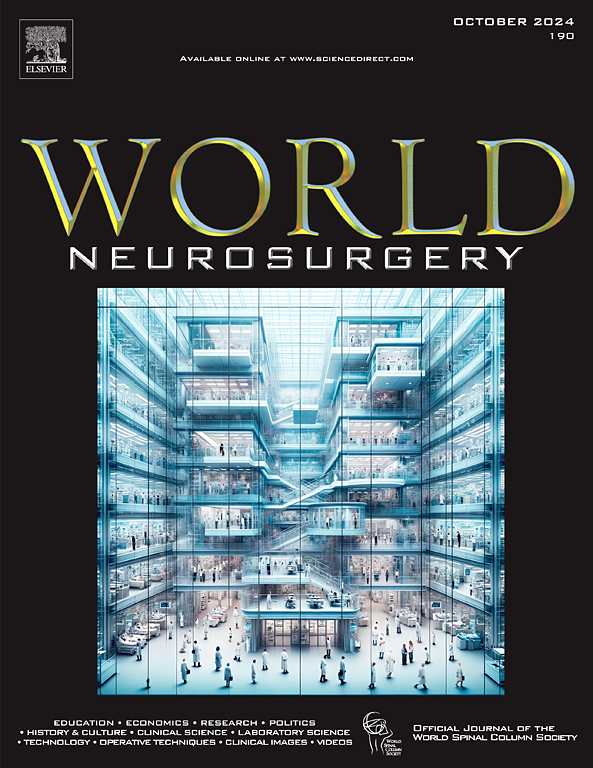残余青少年特发性脊柱侧凸和胸腰椎/腰椎弯曲患者侧移的影像学预测因素:聚焦 L3 侧移。
IF 1.9
4区 医学
Q3 CLINICAL NEUROLOGY
引用次数: 0
摘要
背景:残余青少年特发性脊柱侧凸(AIS)和胸腰椎/腰椎(TL/L)弯曲患者在停止生长后可能会出现脊柱侧凸,而侧移是一个主要的风险因素。然而,影像学预测因素和内在机制仍不明确。本研究旨在确定残余 AIS 患者的影像学预测因素和结构机制:方法:本研究收集了 45 例术前有残留 AIS 且 TL/L Cobb 角大于 40°、随后在本院接受矫正手术的连续患者的影像学和临床数据。侧移定义为计算机断层扫描上椎体间滑移≥6 mm。统计分析包括学生 t 检验、皮尔逊相关系数、接收器操作特征(ROC)曲线分析和多变量逻辑回归分析:45 名患者中,男性 3 人,女性 42 人,平均年龄(40.6±17.4)岁。21例患者出现L3滑脱,因此分为滑脱组和非滑脱组。多变量逻辑回归分析显示,两组患者的双侧关节面角度、关节面开放度和关节面真空现象在统计学上存在显著差异。ROC分析确定了预测L3滑脱的20.5°临界值。在非滑脱队列中,特别观察到 L3 滑脱与 L2-L3 桥接之间存在很强的相关性:结论:面关节不稳定、L4倾斜≥20.5°和L3椎体桥接是残余AIS患者L3侧移的影像学预测因素。因此,表现出这些特征的患者需要持续随访或在发生侧移之前尽早进行手术干预。本文章由计算机程序翻译,如有差异,请以英文原文为准。
Radiographic Predictors of Lateral Translation in Patients With Residual Adolescent Idiopathic Scoliosis and Thoracolumbar/Lumbar Curves: A Focus on L3 Lateral Translation
Background
Patients with residual adolescent idiopathic scoliosis (AIS) and thoracolumbar/lumbar curves may present with progression after cessation of growth, with lateral translation as a major risk factor. Nonetheless, radiographic predictors and underlying mechanisms remain indefinite. This study aimed to determine these radiographic predictors and structural mechanisms in patients with residual AIS.
Methods
Radiographic and clinical data were collected from 45 consecutive patients with preoperative residual AIS and thoracolumbar/lumbar Cobb angle >40° who subsequently underwent corrective surgery at our institution. Lateral translation was defined as intervertebral slippage ≥6 mm on computed tomography. Statistical analyses included Student’s t-test, Pearson’s correlation coefficients, receiver operating characteristic curve analysis, and multivariate logistic regression analysis.
Results
Of 45 patients, 3 were male, whereas 42 were female, with a mean age of 40.6 ± 17.4 years. L3 slippage was observed in 21 patients, resulting in the categorization into the slippage and nonslippage cohorts. Multivariate logistic regression analysis revealed statistically significant disparities in the bilateral facet angles, facet joint opening, and facet joint vacuum phenomenon between the 2 cohorts. The receiver operating characteristic analysis determined a 20.5° cut-off value for predicting L3 slippage. In the nonslippage cohort, a strong correlation was particularly observed between L3 slippage and L2–L3 bridging.
Conclusions
Facet joint instability, L4 tilt ≥20.5°, and L3 cranial vertebral bridging are predictive radiographic factors for L3 lateral translation in patients with residual AIS. Thus, patients exhibiting these characteristics require consistent follow-up or early surgical intervention before lateral translation occurs.
求助全文
通过发布文献求助,成功后即可免费获取论文全文。
去求助
来源期刊

World neurosurgery
CLINICAL NEUROLOGY-SURGERY
CiteScore
3.90
自引率
15.00%
发文量
1765
审稿时长
47 days
期刊介绍:
World Neurosurgery has an open access mirror journal World Neurosurgery: X, sharing the same aims and scope, editorial team, submission system and rigorous peer review.
The journal''s mission is to:
-To provide a first-class international forum and a 2-way conduit for dialogue that is relevant to neurosurgeons and providers who care for neurosurgery patients. The categories of the exchanged information include clinical and basic science, as well as global information that provide social, political, educational, economic, cultural or societal insights and knowledge that are of significance and relevance to worldwide neurosurgery patient care.
-To act as a primary intellectual catalyst for the stimulation of creativity, the creation of new knowledge, and the enhancement of quality neurosurgical care worldwide.
-To provide a forum for communication that enriches the lives of all neurosurgeons and their colleagues; and, in so doing, enriches the lives of their patients.
Topics to be addressed in World Neurosurgery include: EDUCATION, ECONOMICS, RESEARCH, POLITICS, HISTORY, CULTURE, CLINICAL SCIENCE, LABORATORY SCIENCE, TECHNOLOGY, OPERATIVE TECHNIQUES, CLINICAL IMAGES, VIDEOS
 求助内容:
求助内容: 应助结果提醒方式:
应助结果提醒方式:


